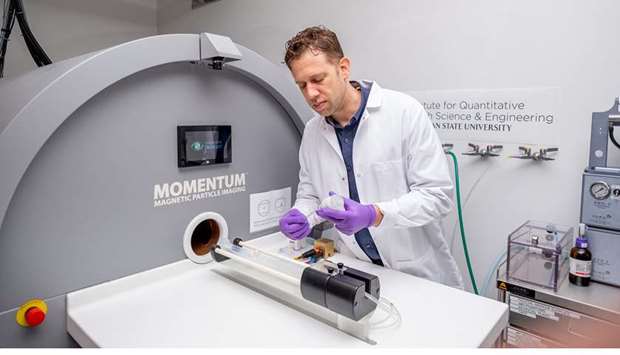Bryan Smith, 40, came to MSU in late 2018 from Stanford University, where he and a few other extremely smart people figured out they could direct nanoparticles to tell cells to engulf and eat the arterial debris that can cause heart attacks.
The hope, he says, is that their tiny Trojan horses “can reduce the need for bypass surgery, for stents and for other drugs.”
Assuming it works, it’s probably a decade away from actually saving lives.
As Smith and his colleagues continue the arduous process of testing their creation and bringing it to market, however, it’s a fine time to be astonished at just how small a nanoparticle is. Consider the human hair and the concept of a trillion.
“Classically,” Smith says, “the width of a human hair is 50 microns.” That changes a bit by individual and how much they spend on conditioner, but still: 50 microns, which translates to 50,000 nanometres.
One trillion, meantime, is a million millions.
Smith’s nanoparticles are two nanometres in diameter, which means a hair is 25,000 times their width. And the number of nanoparticles it took to inject 40 mice in the lab, he says, was about a quadrillion, which is a thousand trillions.
The next logical question is what kind of container holds a quadrillion nanoparticles. Do they fit in a thimble? A syringe? A medium-sized squirt gun?
Like many medications, Smith says, each mouse dose was suspended in a saline solution for proper dilution.
The entire swarm of dark black nanoparticles, however, “can easily fit into a syringe, and could fit within a drop from an eyedropper if you really scrunch them together.”
Scrunched or otherwise, “it’s astonishing when I think about it sometimes,” Smith says. “But people have been doing all kinds of fun things to molecules for years.”
He joined the nanoparticle party after growing up in Cincinnati and earning a PhD. in biomedical engineering from Ohio State. In deference to his Big 10 colleagues and his health, he says, he only displays his OSU memorabilia at the East Lansing home he shares with wife Ziba, an MSU research grants administrator, and their 3-month-old daughter, Adara.
Smith had set out to be a veterinarian like his dad but discovered he loved animals too much to watch them die.
Fortunately, he also loved asking how-does-this-happen sorts of questions, to the point where “I annoyed the heck out everybody. I wanted to know how nature worked.”
The language of that area is math, which he turned out to speak fluently. That led him to a teaching position at Stanford, where he found cardiologist Nicholas Leeper, who’d published a paper that showed how immune cells called macrophages were being told not to eat the plaque dandruff within arteries that can lead to atherosclerosis.
Atherosclerosis is a specific type of arteriosclerosis, or hardening of the arteries, that can be a highway to cardiac arrest or stroke.
Smith, Leeper, postdoctoral research fellow Niloufar Hosseini Nassab, medical student Alyssa Flores and a cast of colleagues focused on selectively intercepting the signalling of receptors within the macrophages and sending out messages to get busy.
The base nanoparticles are created through what’s known as a high-pressure carbon monoxide process. HiPco is the gas-phase reaction of a highly pure iron, often a gray powder, with high-pressure carbon monoxide gas.
The team can create them in a day, Smith says, but frequently buys them from a Canadian company because it’s cheaper. It’s a two-day effort to render them biocompatible, affix polymers to allow them to work in a syringe, and lace them with chemicals.
“They’re targeting turning off the turn-off process,” says physician and Wayne State professor Phillip Levy, board president of the Detroit division of the American Heart Association. “By doing that, they can restimulate the macrophages to start consuming debris and shrink the size of the plaque from within.
“It’s actually a really cool idea.”
At Beaumont Health, Justin Trivax notes that he and other interventional cardiologists are “sceptical of many treatment modalities,” no matter how promising they seem in the early stages.
He is intrigued, however, with the nanoparticles’ potential for treating high-risk patients or those who arrive in the midst of a mini-stroke or heart attack.
“Atherosclerosis is stable until it’s not. We just don’t know when that’s going to be,” Trivax says. “That’s why this shows some promise.”
The inventors have filed for a provisional patent, and Smith says the Stanford patent office will be looking for a partner to develop the discovery for clinical use.
While he holds several patents and teaches a year-long class on medical-technical entrepreneurship, “I’ve never been through this whole process, taking something from bench to bedside,” he says.
It should be interesting, he predicts, if potentially frustrating.
The nanotherapy will be tested in rabbits, then other animals, then people. A toxicity study will need three to five years. After that would come clinical trials, assuming the treatment aces all the earlier tests.
“I’d say we’re looking at eight years total,” Smith says, “as a super-optimist, assuming everything goes perfectly, which I’ve never heard of in the history of medicine.”
So likely 10 years, which feels like forever when he talks to people who need help now.
But when he speaks to other scientists who’ve jumped through the hoops, he says, “I feel like we’re on a really good track” — a little bitty one, with a line of tiny nanohurdles.
— The Detroit News/TNS

